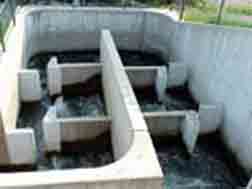

Throughout the years, shad have been a very important part of the lives
of those who have lived along the Lehigh River. This type of fish is
white in color with firm, rich flesh. The Lenni Lenape would eat shad,
cooking these fish on long wooden sticks over a fire. The Europeans
soon learned that shad provided a tasty meal as well. However, the unbelievably
intricate bone structure of this fish was one major drawback. The Lenni
Lenape even referred to the shad as a "porcupine-fish-turned-inside-out."
The Lehigh River provided an excellent environment for shad fishermen.
It was wide and deep enough to attract the shad, but not too deep or
rapid to scare fishermen from wading into the river. A particular shad
fishing spot that was popular with the Moravians was between the ferry
(near the Hill-to-Hill Bridge) and the fish dam (east of Sand Island).
This was because this portion of the river provided a relatively shallow
stretch of water.
Shad live their lives in both salt and fresh water. During the winter
months, shad live in the Atlantic Ocean, where the water temperature
is warmer than in the Delaware or Lehigh Rivers. Once the water begins
to get warmer, around early March, the shad start to swim up the Delaware
River. Moravian records indicate that the shad would usually arrive
in Bethlehem in late April or early May. The shad’s goal during
their ascension up the river was to locate the spot of their birth.
Once this was accomplished, the shad would proceed to lay their eggs
and new life was formed. All surviving shad would then migrate back
to the Ocean for the cold winter months.
When the Lenni Lenape Indians and the Moravians fished for shad, the
Lehigh River was exceptionally clean. Our country had not yet been hit
with the problem of pollution. The first blow against shad in the Lehigh
River occurred when coal mining began near Mauch Chunk. Quite a bit
of coal was lost in the River when it was shipped downstream on boats.
Therefore, the water quality began to decrease. A more efficient means
of coal transportation was sought and the canal was finished in 1829.
The dam that went across the Lehigh River at the Forks of the Delaware
was finished as well, blocking all shad from any potential pursuit up
the Lehigh River for over 150 years.
The rise of industry had negative effects on the water quality of the
Lehigh River. Acid mine drainage in the tributaries around Mauch Chunk
killed all life in the waters that drained into the Lehigh River. Coal
silt was also highly detrimental to all aquatic life. Various other
industries including iron mills, zinc refineries, and coal yards contributed
to the pollution of the river.
In 1955, hurricanes Diane and Connie swept down the East Coast. Although
their damage to the Delaware Valley was horrific (property damage and
loss of lives), the pollutants and silt build-up in the Delaware River
were swept away. By the spring of 1960, shad returned to the Delaware
River, but not the Lehigh River due to the dam at Easton.
By 1968, the shad had once again disappeared. Both the Lehigh River
and Delaware River were teeming with pollution. There was a 60-mile
stretch of the Delaware River which became know as the pollution block.
This area was located around the cities of Philadelphia, Camden, and
Wilmington. The pollution caused the dissolved oxygen levels in that
particular area to dip so low that the shad could not breathe (below
four parts per million).
The Clean Water Act of 1970 began the turn around regarding pollution
in the Delaware and Lehigh Rivers. Sewage treatment plants and industries
were forced to decrease the amount of pollutants that were released
into the surrounding bodies of water. The numbers of shad in the Delaware
River began to increase once again. Industries along the Lehigh River
such as Bethlehem Steel and New Jersey Zinc Company cleaned up their
act as well. Aquatic life began to return to the Lehigh River, which
had been full of pollutants since the industrial revolution. In the
1980’s, Bethlehem Steel began to decrease their output of steel
and the New Jersey Zinc Company ceased their operations. This also caused
a further increase in the water quality of the Lehigh River.
The Lehigh River still did not have any shad in its waters because of
the dams at Easton and Glendon. After much debate, the "Shad Ladder
Bill" was passed in 1989. This bill provided $3.3 million towards
the construction of fish passageways at the sites of both of the dams
on the Lehigh River. This provided a means for shad to travel up the
Lehigh River, something which had not been done since 1829. At the Easton
site, there is actually a public viewing site where visitors can see
the shad travel upstream through a large glass window. There is also
scientific equipment which allows scientists to count the number of
shad that travel through the ladder (Dennis Scholl, 1997).
